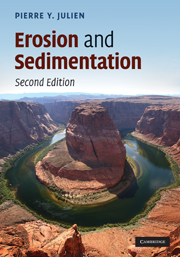Book contents
- Frontmatter
- Contents
- Preface
- List of Symbols
- 1 Introduction
- 2 Physical properties and dimensional analysis
- 3 Mechanics of sediment-laden flows
- 4 Particle motion in inviscid fluids
- 5 Particle motion in Newtonian fluids
- 6 Turbulent velocity profiles
- 7 Incipient motion
- 8 Bedforms
- 9 Bedload
- 10 Suspended load
- 11 Total load
- 12 Reservoir sedimentation
- Appendix A Einstein's Sediment Transport Method
- Appendix B Useful mathematical relationships
- Bibliography
- Index
1 - Introduction
Published online by Cambridge University Press: 05 June 2012
- Frontmatter
- Contents
- Preface
- List of Symbols
- 1 Introduction
- 2 Physical properties and dimensional analysis
- 3 Mechanics of sediment-laden flows
- 4 Particle motion in inviscid fluids
- 5 Particle motion in Newtonian fluids
- 6 Turbulent velocity profiles
- 7 Incipient motion
- 8 Bedforms
- 9 Bedload
- 10 Suspended load
- 11 Total load
- 12 Reservoir sedimentation
- Appendix A Einstein's Sediment Transport Method
- Appendix B Useful mathematical relationships
- Bibliography
- Index
Summary
Erosion and sedimentation refer to the motion of solid particles, called sediment. The natural processes of erosion, transportation and sedimentation, sketched in Figure 1.1, have been active throughout geological time and have shaped the present landscape of our world. Today, they can cause severe engineering and environmental problems.
Human activities usually accelerate the processes of erosion, transport, and sedimentation. For instance, soil erodibility is enhanced by plowing and tillage. The protective canopy is weakened by grubbing, cutting, or burning of existing vegetation. Besides producing harmful sediment, erosion may cause serious on-site damage to agricultural land by reducing the productivity of fertile soils. Under some circumstances, the erosion rate can be 100 to 1,000 times greater than the geological erosion rate of 0.1 ton/acre year (25 ton/km2 year).
Severe erosion can occur during the construction of roads and highways when protective vegetation is removed and steep cut and fill slopes are left unprotected. Such erosion can cause local scour problems along with serious sedimentation downstream. Approximately 85% of the 571,000 bridges in the United States are built over waterways. The majority of these bridges span rivers and streams that are continuously adjusting their beds and banks. Bridges on more active streams can be expected to experience scour problems as a result of stream realignment. Local scour at bridge piers and erosion of abutments are the most common causes of bridge failure during floods.
- Type
- Chapter
- Information
- Erosion and Sedimentation , pp. 1 - 3Publisher: Cambridge University PressPrint publication year: 2010
- 3
- Cited by



